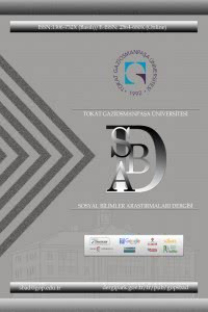Beden Eğitimi Öğretmenlerinin Eğitim Teknolojileri Ve Multimedya Kullanım Becerileri
Eğitim alanında bilgi ve iletişim teknolojileri ve multimedya olanakları son derece yaygınlaşmış ve hemen hemen tüm okulların belirli oranlarda elde edebilecekleri olanaklar haline gelmişlerdir. Formal ve informal eğitimin yanı sıra yaşam boyu öğrenmenin de çok önemli bir öğesi olan beden eğitimi de bu gelişmelerden etkilenmiş ve eğitim teknolojileri ve multimedya, beden eğitimi öğretmenleri tarafından kullanılmaya başlanmıştır. Bununla birlikte kimi zaman teknik olanaksızlıklar, kimi zaman da alınan hizmet içi eğitimin yetersiz olması gibi nedenlerle eğitimsel teknoloji ve multimedya araçları beden eğitimi derslerinde tam olarak kullanılamamakta veya istenen verim sağlanamamaktadır. Bu çalışmada beden eğitimi öğretmenlerinin hangi eğitim teknolojilerini ve multimedya araçlarını ne kadar sıklıkla kullandıkları araştırılmış ve eğer varsa bu araçları yeterince kullanamamalarının nedenleri bulunmaya çalışılmıştır. Ayrıca araştırma bulgularına göre, beden eğitimi öğretmenlerinin eğitim teknolojilerinden daha iyi yararlanabilmelerine yönelik önerilerde bulunulmuştur
In the field of education, information and communication technologies and multimedia tools have become more prevalent then ever that almost all schools can obtain. Physical education which is not only very important component of formal and informal education but also an important part of lifelong learning has been affected by these developments and physical education teachers has begun to use educational technologies and multimedia. On the other hand, because of some reasons like lack of technical facilities and inadequate in-service training, educational technologies and multimedia tools are either not used in physical education classes or used ineffectively. In this study, how often and which educational technologies and multimedia tools are used by physical education teachers and – if there are – the reasons for ineffective use of these tools are investigated. Moreover, based on the findings of the study, some suggestions for physical education teachers to use educational technologies better are made
___
- Akkoyunlu, B. (2002). “Educational Technology in Turkey : Past, Present and Future”. Education Media International. 39 (2), 165-173.
- Assiri, M. A. (2003). Exploring the Attitudes and Practices of Northwest Arkansas High School Mathematics Teachers Regarding Technology. Arkansas : University of Arkansas (Unpublished Doctorial Dissertation).
- Bird, V. (1998). Ensenando Educacion Fisica. Carolina, PR: Editorial Logo.
- Boucher, R. (1993). “Reinventing Virginia’s Schools Through Technology”. Virginia Forum. 11 (2).
- Charp, S. (2000). “Internet Usage in Education”. THE Journal. May2000. 27 (10).
- Cuban, L. (1993). How Teachers Taught: Constancy and Change in American Classrooms: 1890-1990. New York: Teachers College Press.
- Dusick, D. M. (1998). What Social Cognitive Factors Influence Faculty Members’ Use of Computers for Teaching? A Literature Review. Journal of Research on Computing in Education. 31 (2), 123-140.
- Electronic Education Report. (2002). Teacher Internet Usage Improves, Says Study. Simba Information : Stamford, September 27.
- Esquilin, J. M. P. (2004). Teachers’ Attitudes Concerning Their Preparation, Acceptance, and Use of Computer Technology in Physical Education Classes in Junior High Schools of the Fajardo Educational Region, Puerto Rico. New York: Dowling College (Unpublished Doctorial Dissertation).
- Hansen L.R.; Witfelt, C. (1999). “Scientific Report On Identified Technical- Pedagogical Competencies Needed by Teachers In Order To Fully Exploit Educational Multimedia Products’Potentials and to Enable Them to Give Feedback and Give Recommendations to Designers of Educational Multimedia”. Royal Danish School of Educational Studies. Copenhagen.
- Hedberg, J. G.; McNamara, S. (2002). “Innovation and Re-Invention : A Brief Review of Educational Technology In Australia”. Education Media International. 39 (2), 111-121.
- Jones, R.T. (1997). Prediction of Educational Technology to be Found in the Public Schools of the Year 2000: An International Delphi Study. Virginia : Polytechnic Institute and State University (Unpublished Doctorial Dissertation).
- Levie, W.H. (1978). Principles For Attitude Change. Fleming, M.L. and Levie, W.H. (Eds). “Instructional Message Design, Principles From thre Behavioral Sciences”. New Jersey : Educational Technology Publications, Englewood Cliffs.
- Mohnsen, B. (2001). “Instructional Software To Meet National Standarts”. JOPERD. 71 (3), 19-22.
- McKethan, R.; Everhart, B. “The Effects of Multimedia Software Instruction and Lecture-Based Instruction on Learning and Teaching Cues of Manipulative Skills on Preservice Physical Education Teachers”. Physical Education. 58 (1), LateWinter2001.
- Office of Technology Assesment. (1988). Power On New Tools for Teaching and Learning, (Report No : OTA-SET-379). Washington, D.C. : U.S. Government Printing Office.
- Rousseau, J.J. (1762/1933). Emile. (Translated by B. Foxley). New York : E.P. Dutton.
- Sheingold, K.; Hadley, M. (1990). “Accomplished Teachers : Integrating Computers into Classroom Practice”.Technical Report, Center for Technology in Education, Bank Street College of Education.
- Shephard, K. (2004). “The Role of Educational Developers in the Expansion of Educational Technology”. International Journal of Academic Development. 9 (1), 67-83.
- Skolnick, R.; Larson A.; Smith C. (1993). “The Power of Media”. The American School Board Journal. 180 (9), 6-10.
- Smarkola, C. (2004). Comparison Between Student Teachers’ and Classroom Teachers’ Computer Usage Intentions and Self-Reported Computer Usage. U.S.A.: Temple University (Unpublished Doctorial Dissertation).
- Thornburg, R.; Hill, K. (2004). “Using Internet Assessment Tools for Health and Physical Education Instruction”. TechTrends. 48 (6), 53-70.
- Winn, W. (2002). “Current Trends in Educational Technology Research: The Study of Learning Environments”. Educational Psychology Review. 14 (3), 331-350.
- Wood, S.L.; Lynn, S. (2000). “Teaching Elementary Physical Education”. Web Gym. 11 (5), 28-30.
- Witfelt, C. (2000). “Educational Multimedia and Teachers’ Needs for New Competencies: A Study of Compulsory School Teachers’ Needs for Competence to Use Educational Multimedia”. Educational Media International. 37 (4), 235-241.
- Zhu, J. (2003). Application of Computer Technology in Public School Classrooms: Usage Dimensions and Influencing Factors. U.S.A.: The Pennsylvania State University. (Unpublished Doctorial Dissertation).
- ISSN: 1306-732X
- Yayın Aralığı: Yılda 2 Sayı
- Başlangıç: 2006
- Yayıncı: Gaziosmanpaşa Üniversitesi Sosyal Bilimler Enstitüsü
Sayıdaki Diğer Makaleler
Beden Eğitimi Öğretmenlerinin Eğitim Teknolojileri Ve Multimedya Kullanım Becerileri
Teknik Eğitim Fakültelerine Öğrenci Yöneliminin Çoklu Zeka Kuramı Açısından Değerlendirilmesi
Bilgisayar Öğretimi İçin Benzetim Yöntemine Dayalı Yazılım Tasarımı ve Uygulaması
Ünal ÇAKIROĞLU, Ayça ÇEBİ, Çiğdem BEZİR
Sanal Aydınlatma Tekniğinin Aydınlatma Eğitimindeki Önemi
1979 ile 2006 Yılları Arası Türkiye’deki Sınıf Öğretmeni Yetiştirme Programlarının Karşılaştırılması
